Would you like to perform steep climbs, sharp banks, and quick descends with wind in your hair and a smile on your face? That’s what you will get with Alabeo’s Cessna C188B AGtruck. Let’s take a look at the history of this sturdy, fun airplane and find out what Alabeo did to bring it to life for FSX.
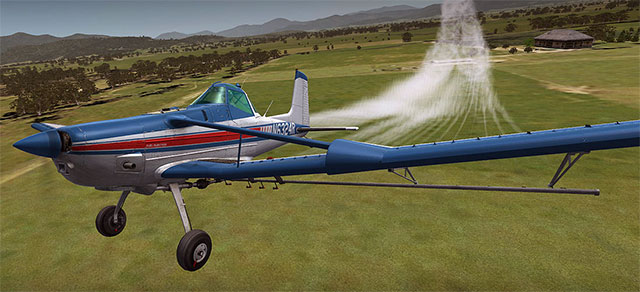
Cessna 188B AGtruck History
The Cessna 188B AGtruck is one of several variants of agricultural aircraft Cessna developed from the early 1960s to the mid-1980s. The 188B was in production in the early to mid-1970s. Other models in the series include "AGpickup," "AGhusky," and "AGwagon." This Cessna began flying in the winter of 1965 and production began the following year.
Cropduster Market
Cessna made the decision to enter the market for agricultural aircraft--cropdusters and other utility planes-- in the early 1960s. They talked to a wide variety of people in the industry to determine what people wanted in an ideal agricultural aircraft. The end result was the Cessna 188, a single-seater with low wings supported by struts.
This design was inspired by the Cessna 180, sharing a similar tale cone and engine. The airframe of the 188 is made from 2024-T3 aluminum, and the hopper for distribution of the chemicals is made from fiberglass. Later models introduced pressurization to help reduce any chemicals infiltrating the frame. The pressurization process came from the pressure of the aircraft's forward momentum.
The Cessna 188 has proven to be extremely popular and stable. The design has been so successful that it remained virtually unchanged over its 17-year production run. Some changes were made to the chemical distribution system, the ventilation system, and other minor modifications.
While the Cessna 188 is best known as an agricultural aircraft, it was also used to tow gliders and sailplanes, among other utility roles. Almost 4000 Cessna 188s of different variants were produced over the aircraft's life cycle.
Variants of the Cessna 188 included:
188 AGwagon 230
Certified in February of 1966, this was the initial version of the 188 and was powered by a Continental engine producing 230 hp. It had a 200 gallon, or 760 Liter, chemical hopper. In the normal category, its gross weight was 3300 pounds, or 1497 kilograms. In the restricted category, it weighed in at 3800 pounds, or 1724 kilograms.
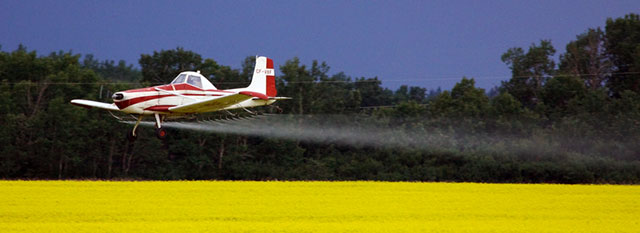
188A AGwagon "A"
Three years later, the 188A AGwagon “A” was certified in September of 1969. It was driven by a Continental 230 hp powerplant, a 200 gallon, or 760 Liter chemical hopper, and weighed in the normal category at 3300 pounds, or 1497 kilograms. In the restricted category, it came in at 3800 pounds, or 1724 kilograms.
188A AGwagon "B"
The “B” Model of the 188A AGwagon was also certified in September of 1969. It had the same powerplant and weight specifications as the “A” model.
188B AGpickup
In December of 1971, Cessna certified the 188B AGpickup model, and production continued until 1976. It featured a Continental O-470-R or O-470 powerplant that produced 230 hp. It had a 200 gallon, or 760 Liter chemical hopper. In the restricted weight class, it came in at 3800 pounds, or 1724 kilograms. In the normal category, it clocked in at 3300 pounds, or 1497 kilograms.
A188 AGwagon 300
The original version of the A188 AGwagon 300 was certified on Valentine's Day in 1966. It sported a Continental IO-520-D 300 horsepower engine with a 200 gallon, or 760 Liter chemical hopper. In the normal weight class, it came in at 3300 pounds, or 1497 kilograms. In the restricted category, it weighed in at 4000 pounds, or 1814 kilograms.
A188A AGwagon "A"
The A188A AGwagon “A” was certified in September of 1969. It featured a Continental IO-520-D engine that generated 300 horsepower. The chemical hopper was measured at 200 gallons, or 760 Liters. The aircraft had a normal category weight of 3300 pounds, or 1497 kilograms. Its restricted category weight was 4000 pounds, or 1814 kilograms.
A188A AGwagon "B"
The A188A AGwagon “B” also had a Continental IO-520-D 300 horsepower engine. In the normal category, it had a weight of 3300 pounds, or 1497 kilograms, and in the restricted category, it clocked in at 4000 pounds, or 1814 kilograms. It was also certified in September of 1969.
A188B, AGwagon "C" and AGtruck
Three models, the A188B, the AGwagon “C”, and the AGtruck were certified on December 20 of 1971. Each was powered by a Continental IO 520D, 300 horsepower engine, and featured a 280 gallon, 1060 Liter chemical hopper. In the normal category, they came in at 3300 pounds, or 1497 kilograms. In the restricted category, these models weighed in at 4000 pounds, or 1814 kilograms.
T188C AGhusky
The latest model in the series, the T188C AGhusky was certified in September of 1978, and production ended in 1985. This model featured a turbocharged Continental TSIO 520 T, 310 hp powerplant, with a 280 gallon, 1060 liter chemical hopper. Its normal category weight was 3300 pounds, or 1497 kilograms. In the restricted category, it came in at 4400 pounds, or 1996 kilograms.
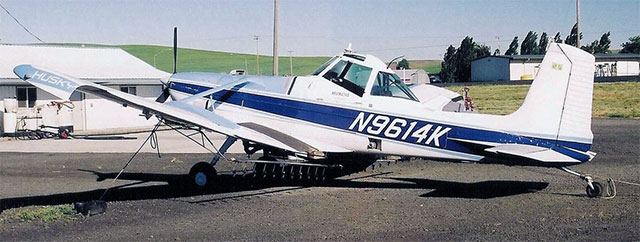
Alabeo’s C188B AGtruck
Alabeo's AGtruck features custom sounds, original 3-D modeling, detailed shines and reflections, excellent flight dynamics and blank textures for users to create their own designs. As an agricultural workhorse, it also comes with chemical fumigation, a loader interface and real-time reduction in onboard weight as chemicals are released. In other words, it gets lighter as the pilot drops the chemical load.
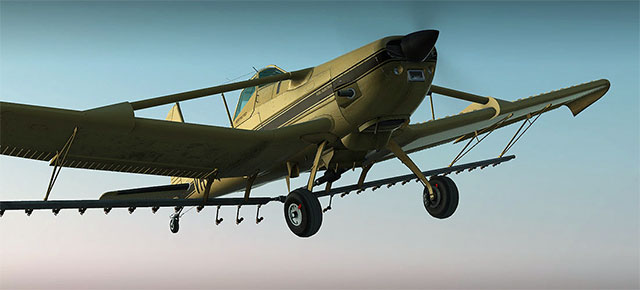
Alabeo's graphics are detailed and accurate to the real-world model. This is easy to confirm because the package comes with several photographs of the real aircraft. There are 11 liveries, five with dispersal gear, five without, and a blank white version that can be used for repainting.
Accurate Interior
Alabeo put considerable effort into the cockpit interior. Pilots will really feel the claustrophobia of the small, cramped quarters, as they look over the instruments, placards and various controls. There are tooltips available on every control, indicating items such as the chemical hopper release, and the hand brake. All the tools and equipment to begin crop dusting is ready to go.
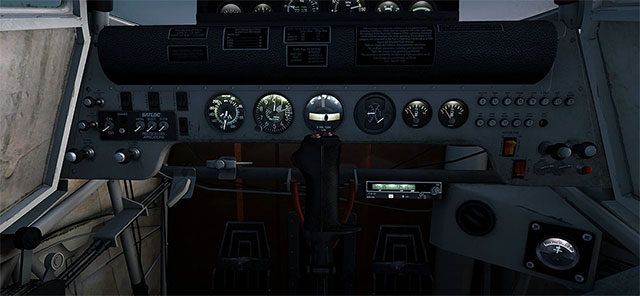
The instrument panel is very accurate to the original C188B. Pilots new to this aircraft will note that the instruments are aligned along the top, while performance data is placed in placards in the center, and the flight instruments are situated below that. While all of the necessary instruments are available, they are situated very differently than most pilots are used to.
One peculiarity is that there are no indicators for vertical speed or attitude. Because an agricultural aircraft such as this makes so many quick climbs, pilot skill with visual flying is paramount. There are various pop-ups that pilots can utilize. One pop-up window is for a "control window." Here the pilot can choose transparent, or non-transparent canopy, a helmet visor, and either a closed or open canopy. Other pop-up windows are available for "radio" and "chemical indicator."

Data Documents
Unfortunately, documentation in the package is limited. Alabeo has included a couple of data sheets: The first is a one-page document showing airspeed indicators and engine data. The copyright sheet is another one-page document showing the company contact information and appropriate copyrights.
While there are no checklists in the documentation, there are several placards attached to the instrument panel. These placards show flap settings, maximum flap speed, maximum allowed manifold pressure, and other important information.
Unfortunately, there is nothing that describes how to properly operate the chemical dispersion equipment. This would have been useful, as distributing chemicals is one of the primary functions of agricultural aircraft.
Without such documentation, users might get frustrated because none of the tooltips or indicators handles the distribution of chemicals. The answer turns out to be simple: press the numeral 1 key to activate the sprayers, and press Shift + 3 to load more chemicals. Some users assign an unused joystick button to handle this function, so they don't have to remember keystrokes or locate any levers.
Additional features include working windows on both sides of the canopy, and a working pilot entry/exit door. The helmet visor can be used either up inside the helmet, or simply set in front of the pilot’s eyes.
Exterior Textures
The exterior textures of the aircraft are tremendous. There is significant attention to detail, as even the smallest decal and logos are clear and sharp. Alabeo continues the commitment to authenticity by including several stains and blotches on the body, things you would expect from a hard-working agricultural aircraft out in the field every day!

This same authenticity continues on the interior graphics. There are plenty of smudges, stains and scratches. The visibility from inside the cockpit is unparalleled. The design and clarity of the canopy allow pilots full 360-degree views to help ensure the accuracy of their chemical dispersion.
The instrumentation is very sparse, and includes only those required for VFR, with a smattering of engine and other instruments. The single digital readout is for the radio for communications. There are no instruments or communication devices for navigation.
Animated Switches
The interior instrument panel graphics are well done. Despite this, some of the lettering is too small to read, especially when they are squeezed up against switches. Fortunately, tooltips provide details on those areas that cannot be readily deciphered. All the levers and switches are animated, and the switches produce various sounds when toggled.
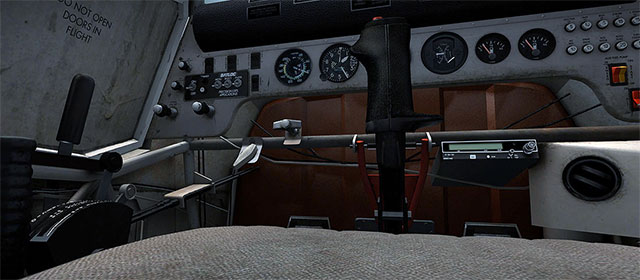
One slight deficiency of the interior is that there is no indicator of the chemical quantity inside the hopper. This makes it hard to know how much is left. Pilots must access the pop-up window for the chemical folder, an additional step which takes away from the overall positive experience of the aircraft.
Excellent Sound
Alabeo went to great lengths to provide excellent animations and sound. The engine produces a throaty, realistic sound, especially when making adjustments to the controls, reducing power or going into a climb. One cool sound is the effect of the wind rushing by an open window while in full acceleration.
Remember that the AGtruck's flight model is designed to handle a full boat of chemicals and fuel. You cannot make the same turns and climbs due to the added weight. Errors are magnified, and stalling is always a possibility.
It takes some practice to get the rhythm of traversing a field, distributing the proper amount of chemicals, and turning properly at the end of each run across the crops. Pilots that don't want to worry about chemical dispersion can use one of the non-dispersal models that are included in the package.
Requirements
Alabeo lists minimum requirements as:
- Either the 32 or 64-bit version of Windows Vista 7.
- Microsoft FSX with SP1 and SP2 (or the acceleration pack). Users can also use the Lockheed Martin Prepar3D flight simulator.
- Pentium V/2GHz or similar – 2GB RAM – 512MB graphics card.
- 395 MB available hard disk space.
Installation and Support
No special settings are needed inside FSX to run C188B AGtruck. Upon activation, the program will distribute each file into the proper folder. The first time the program is installed, FSX will ask if the user wants to operate the chemical equipment and other special tools and instruments. It is recommended that all users choose to activate these files. If not, the special features may not run properly.
The package includes 27 unique sound files, captured from special recording sessions with the original aircraft. There is e-mail technical support available and users can expect prompt response within 24 hours.
Lots of Options
Alabeo has done an excellent job with the C188B AGtruck. The flight model reflects the challenges of flying with a hopper full of chemicals, and a top-offed fuel tank. Pilots will need to practice to really get a feel for this aircraft without stalling out in some lonely cornfield. At the same time, the company realizes that not all pilots want to be cropdusters--those users have the non-dispersal models available.
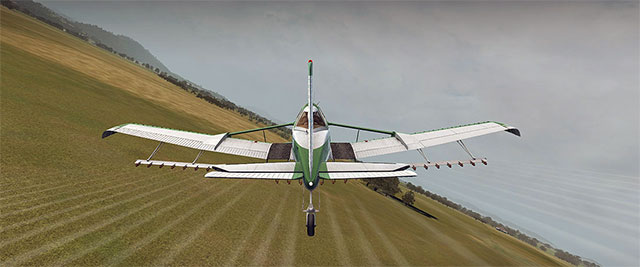
Instruments are beefy and easy to read except for the aforementioned tiny labels next to some switches. The lack of GPS, or any navigational radios and instruments, makes this aircraft a challenge. However, the well-designed canopy provides such clear vision from all angles that it quickly feels comfortable without these navigational aids. If anything, the GPS is useful for mapping out flight plans and locating suitable fields for chemical dispersion.
The textures are tremendous, the animations and sound effects well done, and the flight model that changes as the weight of the plane varies is excellent. On the other hand, the documentation is weak, it is difficult to determine the chemical level, some of the lettering is difficult to read, and the lack of GPS can get annoying over time.
Conclusion
The AGtruck agricultural planes are good examples of the wide variety of aircraft available in the FSX universe. Pilots will need to develop a delicate touch on the rudder and flaps to properly make turns without losing their place during a cropdusting operation. When the aircraft weight changes as the chemicals are dumped, they must make further reevaluations and adjustments as they go.
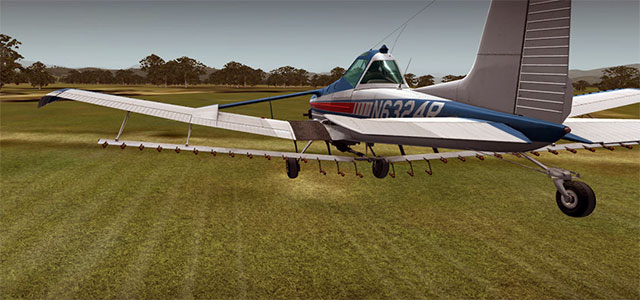
Alabeo are innovative modelers trying to bring different and exciting flying experiences to as many enthusiasts as possible. The AGtruck is a good example. It is an aircraft that many people will never fly. Pilots that get to fly the AGtruck will be sufficiently challenged in all of their flying skills. All in all, this is a tremendous value at a low price. Pick up the Alabeo C188B AGtruck and hit some local fields for some good old-style fun down on the farm.
You can grab your copy of the Carenado AGtruck over at the SimShack.net flight sim store.
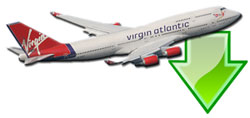 Don't forget... We have a huge selection (over 24,000 files) of free mods and add-ons for MSFS, FSX, P3D & X-Plane in the file library. Files include aircraft, scenery, and utilities All are free-to-download and use - you don't even need to register. Browse on down to the file library here.
Don't forget... We have a huge selection (over 24,000 files) of free mods and add-ons for MSFS, FSX, P3D & X-Plane in the file library. Files include aircraft, scenery, and utilities All are free-to-download and use - you don't even need to register. Browse on down to the file library here.



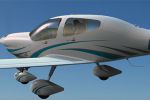
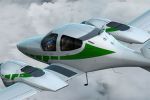

0 comments
Leave a Response